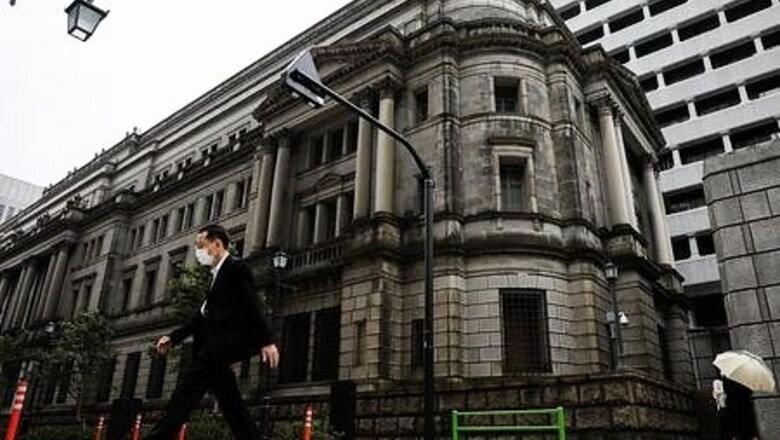
views
TOKYO As the Bank of Japan tries to pump more funds to companies hit by the coronavirus pandemic, it is offering banks hundreds of millions of dollars in bonuses, a move analysts say is aimed at easing the side-effects of its negative interest rate policy.
Record bank lending in recent months suggests the BOJ’s plan is working — a rare success of late in its battle to revive the economy — but it is also a sign that policymakers’ focus is now more on supporting banks, rather than keeping rates low.
So far, a wall of money printed by the BOJ in recent years has kept a lid on bankruptcies and job losses as the economy tips into a deep recession. But the prolonged battle with COVID-19 is adding to strains on regional banks.
“This is one of the most effective policy moves the BOJ has made in recent years,” said Takehiro Noguchi, senior economist at Mizuho Research.
“The BOJ will likely continue to take steps to alleviate the side-effect of its monetary easing… The BOJ thinks negative interest rates is something it should not have done.”
In March, as COVID-19 clobbered the global economy, the BOJ cobbled together special “coronavirus relief” operations to help keep cash-strapped companies afloat. Under the scheme, the BOJ lends cash to banks against their lending to the private sector, such as loans and bonds, as collateral.
The operation started off quietly but got a major boost after the BOJ decided in April to add a sweetener by giving banks a bonus of 10 basis points (bps) or 0.1% per year, for using the scheme, a bonanza when 10-year government bonds yield 0.04%.
Banks rushed to the plan, gobbling up 27 trillion yen ($250 billion) through the channel by July. That is roughly as much as the amount of banks’ deposits on which the BOJ imposes negative interest rates.
BACKDOOR COMPENSATION
The BOJ went negative in 2016 in an attempt to weaken the yen and lower corporate borrowing costs. But it has imposed a minus 0.1% rate on only a small portion of banks’ deposits, amid concerns the policy could squeeze lenders’ margins and possibly reduce the flow of credit to the economy.
The BOJ has paid 0.1% interest to banks on a total of about 208 trillion yen deposits, while the remainder carries zero interest.
BOJ’s three-tier interest rates https://fingfx.thomsonreuters.com/gfx/mkt/xlbpgbemkvq/20811A.png
The complicated, three-tier interest rate system was intended to keep the benchmark interbank lending rate below zero percent while limiting the negative interest banks have to pay to the BOJ.
But paying additional interest on the new scheme is undermining the case for negative rates even further, analysts said.
“In the grand scheme of things, we could see this as a policy normalisation as well as enhancing support for banks,” said Katsutoshi Inadome, senior strategist at Mitsubishi UFJ Morgan Stanley Securities.
As a result of the BOJ’s move to increase interest payments to banks, the benchmark interbank overnight interest rate has also edged up, staying mostly above minus 0.05%.
The BOJ declined to comment on the matter.
Japan interbank interest rate https://fingfx.thomsonreuters.com/gfx/mkt/qmyvmklyavr/20811M.png
The BOJ’s plan appears to be working so far. Data this week showed banks’ lending rose by a record 6.3% in July from a year earlier to 572.7 trillion yen ($5.36 trillion). That represents an increase of about 26 trillion yen since March, suggesting the BOJ has effectively back-financed nearly all of the bank lending growth since then.
Japan bank lending https://fingfx.thomsonreuters.com/gfx/mkt/xegvbaxenpq/20811E.png
EXTENSION EXPECTED
Although the operation was supposed to be temporary, many market players now expect the BOJ will extend it beyond its scheduled expiry next March.
While backtracking on negative rates could in theory erode the BOJ’s credibility, most market players said the latest scheme was typical of the flexible and often innovative policymaking displayed by Governor Haruhiko Kuroda.
“Should the BOJ ever need to cut interest rates further to ease its policy, the central bank will combine it with more bonus schemes like this, to the extent that the net effect becomes unclear,” said Izuru Kato, chief economist Totan Research.
($1 = 106.7500 yen)
Disclaimer: This post has been auto-published from an agency feed without any modifications to the text and has not been reviewed by an editor




















Comments
0 comment